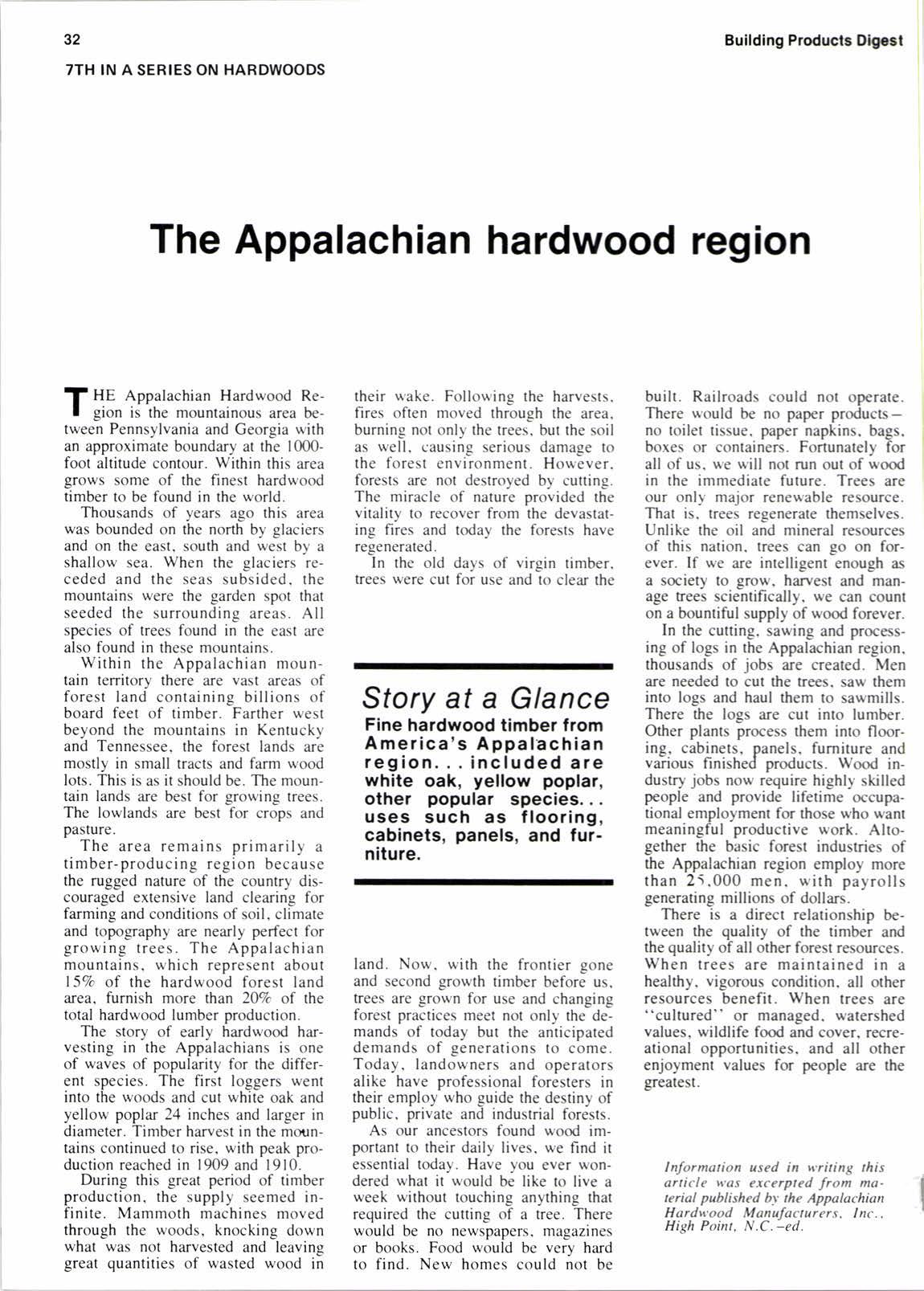
3 minute read
The Appalachian hardwood region
T HE Appatachian Hardwood Re- gion is the mountainous area betwee-n Pennsylvania and Georgia with an approximate boundary at the 1000foot altitude contour. Within this area grows some of the finest hardwood timber to be found in the world.
!
Thousands of years ago this area was bounded on the north by glaciers and on the east, south and west by a shallow sea. When the glaciers receded and the seas subsided. the mountains were the garden spot that seeded the surrounding areas. All species of trees found in the east are also found in these mountains.
Within the Appalachian mountain territory there are vast areas of forest land containing billions of board feet of timber. Farther west beyond the mountains in Kentucky and Tennessee, the forest lands are mostly in small tracts and farm wood lots. This is as it should be. The mountain lands are best for growing trees. The lowlands are best for crops and pasture.
The area remains primarily a timber-producing region because the rugged nature of the country discouraged extensive land clearing for farming and conditions of soil. climate and topography are nearly perfect for growing trees. The Appalachian mountains, which represent about l5Va of the hardwood forest land area. furnish more than 20Vc of the total hardwood lumber production.
The story of early hardwood harvesting in the Appalachians is one of waves of popularity for the different species. The first loggers went into the woods and cut white oak and yellow poplar 24 inches and larger in diameter. Timber harvest in the mountains continued to rise, with peak production reached in 1909 and 1910.
During this great period of timber production, the supply seemed infinite. Mammoth machines moved through the woods, knocking down what was not harvested and leavins great quantities of wasted wood ii their u'ake. Following the harvests. fires often moved through the area. burning not only the trees. but the soil as well. causins serious damase to the forest enviionment. How-ever. forests are not destroyed by cutting. The miracle of nature provided the vitality to recover from the devastating fires and today the forests have regenerated.
In the old days of virgin timber. trees were cut for use and to clear the
Story at a Glance
Fine hardwood timber from America's Appalachian region...includedare white oak, yellow poplar, other popular species. uses such as flooring, cabinets, panels, and furniture.
land. Now. with the frontier sone and second growth timber befori us, ffees are grown for use and changing forest practices meet not only the demands of today but the anticipated demands of generations to come. Today, landowners and operators alike have professional foresters in their employ who guide the destiny of public. private and industrial forests.
As our ancestors found wood important to their daily lives. we find it essential today. Have you ever wondered what it would be like to live a week without touching anything that required the cutting of a tree. There would be no newspapers. magazines or books. Food would be very hard to find. New homes could not be built. Railroads could not operate. There would be no paper producsno toilet tissue. paper napkins. bags. boxes or containers. Fortunately for all of us. u'e will not run out of wood in the immediate future. Trees are our onl;- major rene*'able resource. That is. trees regenerate themselves. Unlike the oil and mineral resources of this nation. trees can go on forever. If we are intelligent enough as a society to grow. harvest and manage trees scientifically. we can counl on a bountiful supply of wood forever.
In the cutting. sawing and processing of logs in the Appalachian region. thousands of jobs are created. Men are needed to cut the trees. saw them into logs and haul them to sawmills. There the logs are cut into lumber. Other plants process them into flooring, cabinets, panels. furniture and vaiious finished producs. Wood industry jobs now require highly skilled people and provide lifetime occupational employment for those who want meaningful productive work. Alrogether the basic forest industries of the Appalachian region employ more than 25.000 men. with payrolls generating millions of dollars.
There is a direct relationship between the quality of the timber and the quality of all other forest resources. When trees are maintained in a healthy. vigorous condition. all other resources benefit. When trees are "cultured" or managed. watershed values, wildlife food and cover. recreational opportunities. and all other enjoyment values for people are the greatest.
Information used in v'riting this article was excerpted from material published by the Appalachian Hardx'ood Manufacturers, Inc., Hiph Point, N.C. -ed.










